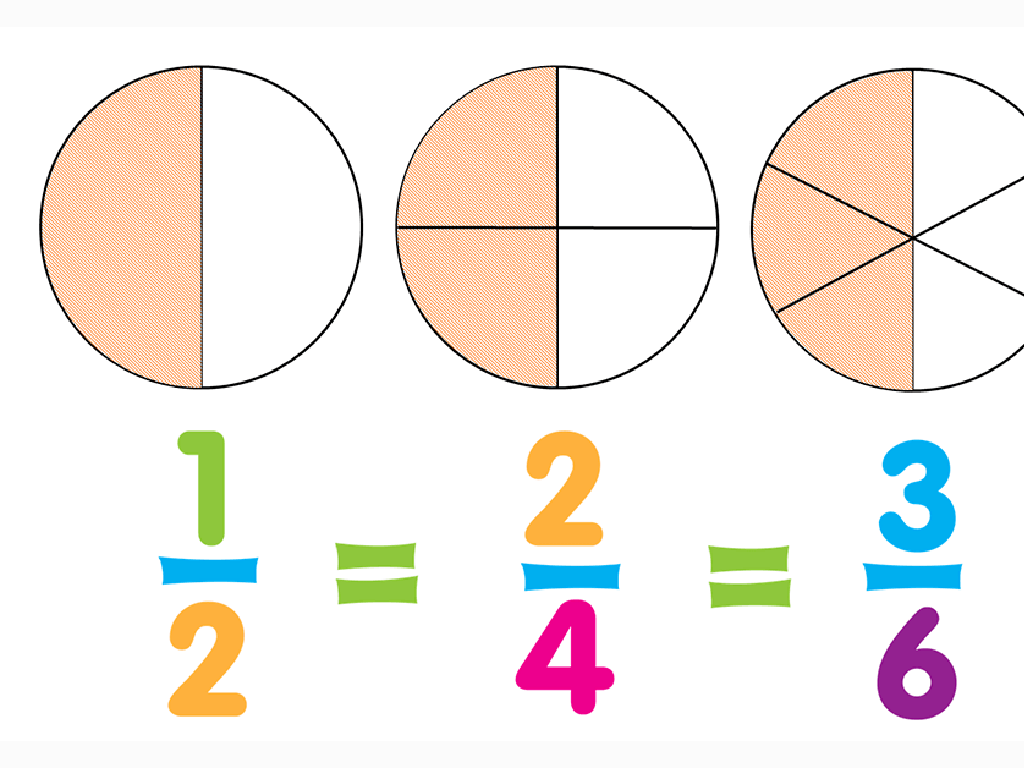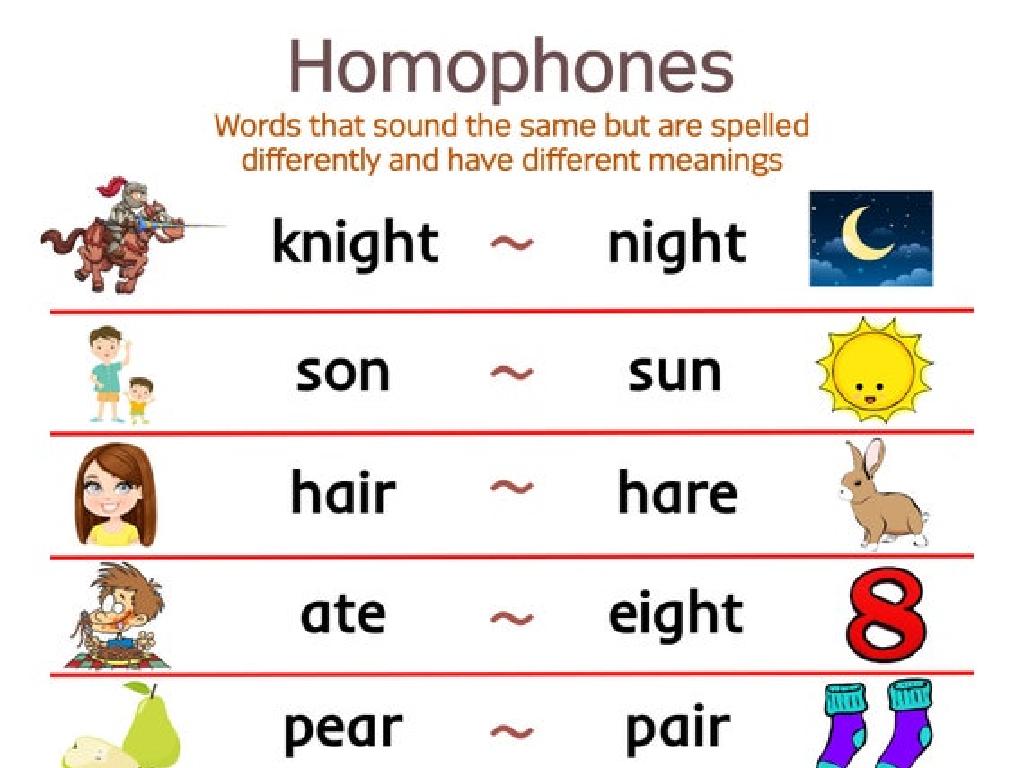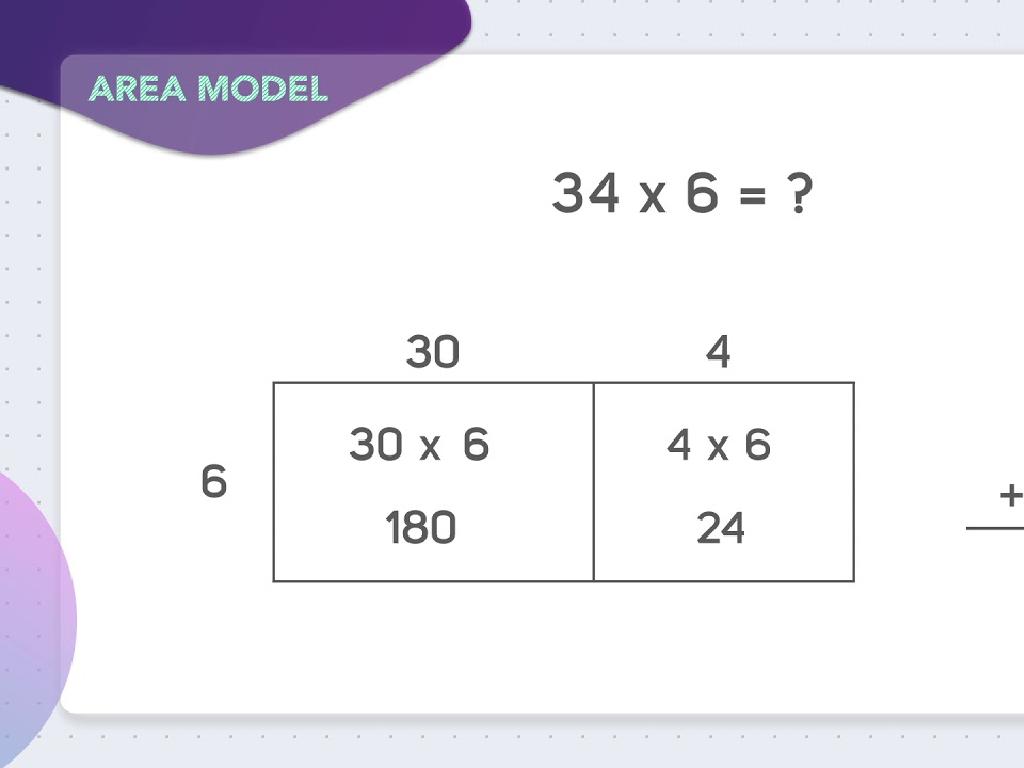Add And Subtract Fractions With Unlike Denominators: Word Problems
Subject: Math
Grade: Fourth grade
Topic: Add And Subtract Fractions With Unlike Denominators
Please LOG IN to download the presentation. Access is available to registered users only.
View More Content
Introduction to Fractions
– Recap: What are fractions?
– Fractions represent parts of a whole, like a slice of pizza.
– Numerators vs. Denominators
– Top number (numerator) shows parts we have, bottom (denominator) shows total parts.
– Everyday life fraction examples
– Pizza slices, sharing candy, measuring cups in recipes.
– Practice with real fractions
|
Begin the lesson by recapping the concept of fractions, ensuring students remember that fractions represent parts of a whole. Clarify the roles of numerators and denominators, using visual aids like pie charts or objects divided into equal parts. Provide relatable examples such as dividing a pizza among friends or using measuring cups while baking to illustrate fractions in everyday life. Encourage students to think of their own examples and share them with the class. Conclude with a hands-on activity where students practice identifying and creating fractions using classroom materials or drawings.
Understanding Like vs. Unlike Denominators
– Define like denominators
– Denominators that are the same in two fractions
– Define unlike denominators
– Denominators that are different in two fractions
– Importance of denominator types
– Knowing the type helps in adding or subtracting
– Strategies for different denominators
– Find a common denominator to solve problems
|
This slide introduces the concept of like and unlike denominators, which is crucial for understanding how to add and subtract fractions. Like denominators are the same in two fractions, making it straightforward to add or subtract the numerators directly. Unlike denominators are different, and they require finding a common denominator before combining the fractions. Emphasize the importance of recognizing the type of denominators to apply the correct strategy. Provide examples and practice problems to illustrate how to find a common denominator and combine fractions with unlike denominators. Encourage students to explain why finding a common denominator is necessary and how it simplifies the process of adding or subtracting fractions.
Visualizing Fractions with Different Denominators
– Use fraction circles for understanding
– Fraction circles represent fractions visually to aid comprehension
– Visual differences in unlike denominators
– See how fractions with different bottom numbers don’t fit together easily
– Activity: Match fractions to visuals
– Find the right visual representation for given fractions
– Discuss the importance of visualization
|
This slide introduces the concept of visualizing fractions using fraction circles, which are a great tool for helping students understand fractions with unlike denominators. Show students how different denominators divide the circle into different numbers of parts, making it clear why adding or subtracting these fractions requires a common denominator. The activity involves matching fractions to the correct visual representation, reinforcing the concept. Emphasize the importance of visualization in understanding mathematical concepts. For the activity, prepare several sets of fraction circles and have students work in groups to match written fractions to the corresponding visual fraction circles. This hands-on experience will help solidify their understanding of the topic.
Adding Fractions with Different Denominators
– Find a common denominator
– A number that both denominators can divide into
– Convert to same denominator
– Change fractions to equivalent ones with the common denominator
– Add the numerators
– Add the top numbers of the fractions
– Simplify the fraction
– Reduce the fraction to its simplest form if possible
|
This slide is aimed at teaching fourth graders how to add fractions with unlike denominators through a step-by-step process. Start by explaining the concept of a common denominator and how to find one, such as the least common multiple of the denominators. Next, show how to convert the original fractions into equivalent fractions with this new common denominator. Once the fractions have the same denominator, guide the students to add the numerators together while keeping the denominator the same. Lastly, demonstrate how to simplify the resulting fraction, if necessary. Provide examples with different sets of fractions to ensure students can practice and apply each step effectively. Encourage students to work through problems and ask questions if they’re unsure about any step.
Subtracting Fractions with Unlike Denominators
– Find a common denominator
– Common denominator is a shared multiple of both denominators
– Convert to same denominator
– Make equivalent fractions with the common denominator
– Subtract the numerators
– Only numerators are subtracted, denominators stay the same
– Simplify the result
– Reduce the fraction to its simplest form if possible
|
This slide introduces the steps to subtract fractions with unlike denominators. Start by explaining the need for a common denominator, which is a number that both denominators can divide into without a remainder. Show how to convert the original fractions into equivalent fractions with this common denominator. Emphasize that when subtracting, only the numerators change. After the subtraction, guide students on how to simplify the fraction, if necessary, by finding the greatest common divisor. Provide examples and practice problems to ensure understanding. For instance, subtract 2/3 from 4/5 by first converting to 10/15 and 12/15, then subtract to get 2/15.
Adding Fractions with Unlike Denominators
– Comprehend the word problem
– Spot fractions with different bottoms
– Denominators are the numbers below the fraction line
– Steps to add these fractions
– Find a common denominator, then add the numerators
– Example: Pizza slices problem
– If you have 3/4 and 2/6 of pizza, how many slices do you have in total?
|
This slide is aimed at helping students tackle word problems involving the addition of fractions with unlike denominators. Start by ensuring they understand the problem by reading it carefully and identifying what is being asked. Next, guide them to recognize fractions with different denominators, explaining that the denominator represents the total number of equal parts. Teach them the steps to find a common denominator and add the numerators to solve the problem. Use an example like combining different pizza slice fractions to illustrate the concept in a relatable way. Encourage students to visualize the problem and work through the steps together as a class.
Subtracting Fractions with Unlike Denominators
– Comprehend the word problem
– Spot fractions with different bottoms
– Find a common denominator
– Use multiplication to make the bottoms the same
– Subtract step by step
– Align the fractions and subtract the tops
|
This slide is aimed at helping fourth-grade students tackle word problems that involve subtracting fractions with unlike denominators. Start by ensuring students understand the problem by reading it carefully and looking for key information. Next, help them identify the fractions involved and note their different denominators. Teach them to find a common denominator by finding a number that both denominators can multiply into. Once they have equivalent fractions with the same denominator, guide them through subtracting the numerators step by step. Encourage students to check their work by adding the difference to the smaller fraction to see if it equals the larger fraction. Provide several practice problems and walk through them together as a class.
Fraction Word Problems: Practice Time
– Solve problems as a class
– Apply learned methods
– Work through new examples
– For example, if 3/4 of a pizza plus 2/3 of another, how much pizza do we have?
– Discuss problem-solving steps
– We’ll identify the problem, find a common denominator, add/subtract, and simplify.
|
This slide is designed to engage students in a collaborative problem-solving activity. Start by solving a couple of problems together as a class to demonstrate the process. Encourage students to apply the methods they’ve learned for adding and subtracting fractions with unlike denominators to new word problems. Provide examples that are relatable to their everyday experiences, such as combining portions of food or measuring lengths. Walk them through each step: understanding the problem, finding a common denominator, performing the addition or subtraction, and simplifying the result. Allow students to discuss their thought process and encourage them to ask questions. This will help solidify their understanding and prepare them for independent practice.
Class Activity: Fraction Scavenger Hunt
– Find classroom items as fractions
– Create word problems with items
– Use items to represent parts of a whole, like a clock or a pizza toy
– Swap problems with a classmate
– Solve your partner’s problem
– Use addition or subtraction of fractions in your solution
|
This activity is designed to help students apply their knowledge of adding and subtracting fractions with unlike denominators in a fun and interactive way. Students will first search the classroom for items that can be used to represent fractions, such as a partially eaten pizza, a clock showing a certain time, or a set of colored pencils with some missing. They will then create word problems based on these items, challenging them to think critically about how fractions are used in everyday contexts. After creating their problems, students will exchange them with a partner and work on solving the new problem they receive. This peer-to-peer interaction encourages collaboration and helps students see a variety of fraction scenarios. As a teacher, be prepared to assist with problem creation and to provide guidance on solving the problems. Possible variations of the activity could include group work, timed challenges, or incorporating mixed numbers for advanced students.
Wrapping Up: Fractions with Unlike Denominators
– Review key fraction concepts
– Homework: Practice with word problems
– Solve problems on adding and subtracting different fractions
– Get ready for a fractions quiz
– Study today’s lessons to prepare for the quiz
– Keep practicing at home!
– Practice makes perfect, try more problems!
|
As we conclude today’s lesson on adding and subtracting fractions with unlike denominators, it’s important to reinforce the key concepts. For homework, students should solve additional word problems to solidify their understanding. Encourage them to use the strategies learned in class. Remind students that there will be a quiz during the next class, so they should review their notes and practice problems. Provide a few example problems for the quiz and suggest that students form study groups if possible. The goal is to ensure they are comfortable with finding common denominators and working through the steps of adding and subtracting fractions.





